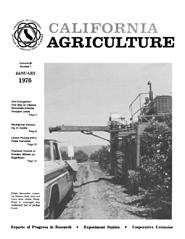


University of California
California Agriculture
|
|||
|
|||

Cover:
Grape harvester removing lemons from close-set trees near Santa Paula. Fruit is conveyed into cushioned bed of pickup truck.
January 1976
Volume 30, Number 1 |
|||
|
University of California, 1301 S. 46th St., Bldg. 478 Richmond, CA
|